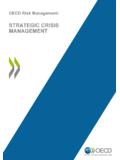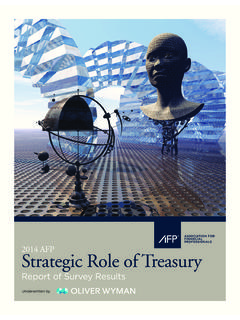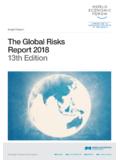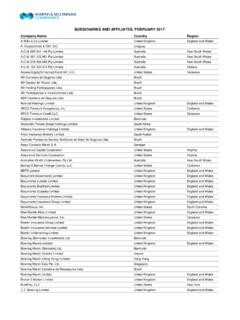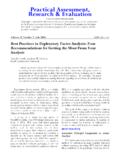Transcription of Material Improbabilities - mmc.com
1 AUTHORR ichard Smith-BinghamMATERIAL IMPROBABILITIESGETTING practical WITH EMERGING RISKSSEVEN TAKEAWAYSW idespread political volatility and rapid technological advances are spurring companies to question not just their resilience, but also their fitness for purpose in the new world order. This requires risk leaders to reflect harder on how their functions can better support organizational agility and strategic analytical approach that is both creative and pragmatic is essential for respecting the inherent messiness of complex uncertainties and securing actionable results. A clear view on the role and value of emerging risk analyses within planning, risk mitigation, and crisis preparedness processes will strengthen organizational commitment to the identification processes need to be explorative and iterative, sourcing ideas widely and triaging them in a way that both challenges orthodox thinking and also secures senior management buy-in.
2 A thorough characterization of each of the top emerging risks helps clarify their materiality and provides an initial steer for response can give shape to plausible alternative futures, including possible shock events. A strategic approach to their generation may usefully expose hidden tensions between commercial ambitions and corporate risk appetite. Scenario narratives and quantification exercises for emerging risks shouldn t be constrained by historic data and risk indicators are vital for engaging senior management at a time when a variety of response options are available, notwithstanding the likely ambiguity of the intelligence.
3 Modern data-science techniques will add increasing value to manual risk-tracking mechanisms and subsequent levers that address a range of top-tier emerging risk concerns may present a more compelling business case than multiple action plans targeting individual issues, especially with regard to pre-emptive responses. Sometimes, aggressive market plays and investment in research and development are more appropriate than defensive mitigation the need to engage with complex uncertainties may take some risk leaders outside their comfort zone. But those who can mesh strategic vision, influencing skills, and technological fluency on top of their core risk-management expertise will be best positioned to help their firms negotiate dynamic risk environments laden with potential shocks and INTRODUCTION5 TRANSFIXED BY UNCERTAINTYT racing the crisis of confidenceUnpacking the problemConnecting with corporate agenda11 FROM GENERAL CONCERNS TO DEFINED CORPORATE RISKSA ligning on prioritiesCharacterizing risks thoroughly18 BUILDING A PLATFORM FOR ACTIONS tressing the futureAssessing response optionsAchieving integration25 A NEW BOLDNESSE xhibit 1.
4 Report flowWHY is the topic important and for whom?HOW can firms determine where to focus?WHAT support do decision-makers need?WHAT does this mean for the Risk function?INTRODUCTIONC ompanies need to rebalance their risk management effort between the risks they can easily specify and the uncertainties that are more elusive, and then engage with the latter in a more dynamic and rigorous first articulated our thinking on this topic in early 2016. The Emerging Risks Quandary set out why companies large and small needed to more effectively anticipate threats that, although complex, are often hidden in plain sight.
5 The paper identified a range of analytical and institutional inhibitors to action, and then set out where firms could do better: diagnosing emerging threats, evaluating their potential impact, and integrating analyses in business lurches in the macro-level risk landscape have injected still greater urgency into this topic, we have revisited those issues to spell out in detail key approaches and techniques. Our purpose is to offer business and functional leaders some creative and pragmatic steps that can help strengthen the evidence base for action and build senior management buy-in at critical junctures.
6 Whether fully integrated or part of a distinct endeavor, these measures will reinforce enterprise risk management frameworks and deliver strategic value. They can be implemented with a light touch or greater rigor as capabilities permit, with processes adapted to institutional report is divided into four parts (see Exhibit 1). Section One lays out the key types of emerging risk and the corporate functions that would benefit most from better intelligence and analysis. Section Two discusses how to move thinking from general concerns to defined risks that are demonstrable threats to the firm. Section Three explores how to build a platform for action through analyzing risk scenarios, evaluating response options, and shaping senior-level discussions.
7 The short concluding section identifies seven initiatives for risk leaders that will help underpin the recommendations in the paper and ensure that company efforts to address critical uncertainties do not founder on the rocks of exigency and 2018 Marsh & McLennan Companies, IncTRANSFIXED BY UNCERTAINTYW idespread political volatility and rapid technological advances are spurring companies to question not just their resilience, but also their fitness for purpose in the new world order. A failure to anticipate possible shocks and disruptions could see firms experiencing nasty surprises and the needless erosion of long-term THE CRISIS OF CONFIDENCEThe financial crisis of 2008 and subsequent recession gave rise to three main challenges and associated risks: first, maintaining liquidity to meet obligations and stay afloat at a time of weak markets and counterparties; second, ensuring robust operations as cost-cutting measures put pressure on personnel and processes.
8 And third, aligning investment and hiring programs with the anticipated economic recovery to optimize market positioning. (The financial sector had additionally to cope with the changing shape and obligations of new regulatory regimes.)Roll forward the best part of a decade and the dominant features of the risk landscape for companies have changed. Even though economic growth has continued to be anemic in advanced economies and volatile in many emerging markets, political sea changes and major technology developments now form the basis of strategic uncertainties. New governmental mandates are introducing obstacles to international investment, trade, and the mobility of talent; further social instability looms in some countries, while geopolitical disagreements are adding friction to international economic relations.
9 The adoption of technological innovation (especially the new wave of automation opportunities) is giving rise new exposures, liabilities, and revenue threats; in some sectors, the disintermediation of value chains and blurring of industry boundaries are beginning to reshape the future competitive opening up a spectrum of possible trajectories and outcomes, the current febrile political environment and the burgeoning fourth industrial revolution are exposing new fault lines between firms risk appetite and their strategic ambitions. Staying out of (or exiting) certain markets for fear of a political crisis might prove expensive, not least if competitors are more bullish; likewise, the pressure for adopting new technologies is intense, even where near-term performance benefits Copyright 2018 Marsh & McLennan Companies, Inc5are uncertain and longer-term ecosystem effects unclear.
10 Historical data is of limited value in quantifying possible impacts, and experts often prove unreliable guides. Over the past two years, economists have faced particular criticism for adhering to base case views and failing to appreciate political factors; political advisers have had their fingers burned by election predictions that have not come to pass; and technology gurus vary wildly from doom-laden scaremongers, to cheerleaders and financial resilience was the major corporate concern during and after the financial crisis, the key issue these days is market positioning. If back then the buzzwords for risk management were prudence and controls, now they are agility and business case support.
